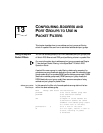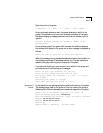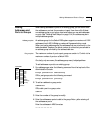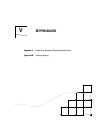
13-6 CHAPTER 13: CONFIGURING ADDRESS AND PORT GROUPS TO USE IN PACKET FILTERS
Port group example In this example, a new port group is created and loaded on the system. The
bit in the port group mask for the group is 12 and the name of the group is
Education. One port is entered and assigned to the group.
Select a bit in the port group mask [3-8, 14-32]: 12
Enter the port group name: Education
Enter the ports for the group - type q to return to the menu:
Port:
Ethernet 2
Port: q
Port Group 6 - Education - has been loaded
Deleting Groups When you delete address or port groups from the system, those groups are
no longer available for use in packet filters.
If you want to use a group later but want to delete it now, first save it to an
ASCII file.
To delete an address or port group:
1 For address groups, enter the following command from the top level of the
Administration Console:
bridge packetFilter addressGroup
OR, for port groups, enter the following command:
bridge packetFilter portGroup
2 Enter this command:
delete
You are prompted for the ID of the address group or port group that you
want to delete.
3 Enter the ID number of the group you want to delete.
Top-Level Menu
system
ethernet
fddi
➧bridge
ip
snmp
analyzer
script
logout
display
ipFragmentation
ipxSnapTranslation
addressThreshold
agingTime
stpState
stpPriority
stpMaxAge
stpHelloTime
stpForwardDelay
stpGroupAddress
port
➧packetFilter
list
display
create
delete
edit
load
assign
unassign
➧addressGroup
➧portGroup


















